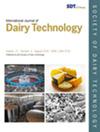Influence of high shear treatment and sodium bicarbonate addition to ultrafiltered retentate of skimmed buffalo milk on the properties of milk protein concentrate prepared therefrom
Abstract
Background
The demand for milk protein concentrate (MPC) has increased in recent years due to its high nutritional and functional properties as a food ingredient. However, the application of MPC is restricted due to its higher calcium and casein content, which lowers its solubility.
Aim
This study investigated the effect of high shear treatment and addition of sodium bicarbonate to ultrafiltered retentate on the physicochemical, solubility and functional properties of milk protein concentrate prepared therefrom.
Methods
Skim milk was ultrafiltered through a 50 kDa ceramic membrane. The obtained ultrafiltered retentate was added to sodium bicarbonate and homogenised using a high-shear mixer. Milk protein concentrate was prepared by spray drying the ultrafiltered retentate added to sodium bicarbonate (MPC-SC). A control was prepared from ultrafiltered retentate without any treatment (MPC).
Major Findings
MPC-SC exhibited higher interstitial air content and occluded air content than MPC. Sodium bicarbonate addition and high shear treatment improved the reconstitutional properties including wettability, dispersibility and solubility. Functional properties of MPC-SC such as water and oil binding capacity, foaming capacity and emulsification stability were significantly (P < 0.05) higher than MPC. With increasing shear rate, reconstituted MPC and MPC-SC showed shear-thinning behaviour. Scanning electron micrographs revealed smooth and round surfaces of MPC-SC particles, while MPC had damaged, wrinkled or irregular surfaces. The increase in pH enhances the negative charge on the phosphoserine residues and disrupts the casein micelles, resulting in smaller molecules that repel each other, thus improving solubility and functional properties of MPC-SC. Sensory attributes exhibited nonsignificantly (P > 0.05) higher scores for MPC-SC than MPC.
Scientific Implications
The results indicate that the addition of alkali and high shear treatment of ultrafiltered retentate could effectively improve the functional properties of MPC. MPC with improved solubility could be used for standardisation of protein content in dairy products such as cheese and yoghurt.


 求助内容:
求助内容: 应助结果提醒方式:
应助结果提醒方式:


